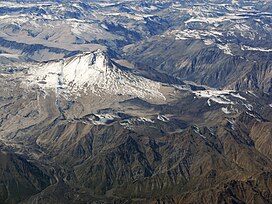
Back سيرو ازول ARZ Cerro Azul (bukid sa Tśile, Maule) CEB Cerro Azul (Chile) Czech Cerro Azul (Chile) German Volcán Quizapú Spanish سرو آزول (آتشفشان شیلی) Persian Cerro Azul (Chili) French Cerro Azul (Chilei vulkán) Hungarian 세로아술산 (칠레) Korean Cerro Azul LLD
| Cerro Azul | |
|---|---|
 Aerial view of Cerro Azul from the west. | |
| Highest point | |
| Elevation | 3,788 m (12,428 ft)[1][2] |
| Listing | List of volcanoes in Chile |
| Coordinates | 35°39′11″S 70°45′40″W / 35.653°S 70.761°W[1] |
| Geography | |
| Location | Chile |
| Parent range | Andes |
| Geology | |
| Rock age | Quaternary |
| Mountain type | Stratovolcano |
| Volcanic arc/belt | South Volcanic Zone |
| Last eruption | August 1967[1] |
Cerro Azul (Spanish pronunciation: [ˈsero aˈsul], blue hill in Spanish), sometimes referred to as Quizapu, is an active stratovolcano in the Maule Region of central Chile, immediately south of Descabezado Grande. Part of the South Volcanic Zone of the Andes, its summit is 3,788 meters (12,428 ft) above sea level, and is capped by a summit crater that is 500 meters (1,600 ft) wide and opens to the north. Beneath the summit, the volcano features numerous scoria cones and flank vents.
Cerro Azul is responsible for several of South America's largest recorded eruptions, in 1846 and 1932. In 1846, an effusive eruption formed the vent at the site of present-day Quizapu crater on the northern flank of Cerro Azul and sent lava flowing down the sides of the volcano, creating a lava field 8–9 square kilometres (3–3.5 square miles) in area. Phreatic and Strombolian volcanism between 1907 and 1932 excavated this crater. In 1932, one of the largest explosive eruptions of the 20th century occurred at Quizapu Crater and sent 9.5 cubic kilometers (2.3 cu mi) of ash into the atmosphere. The volcano's most recent eruption was in 1967.
The South Volcanic Zone has a long history of eruptions and poses a threat to the surrounding region. Any volcanic hazard—ranging from minor ashfalls to pyroclastic flows—could pose a significant risk to humans and wildlife. Despite its inactivity, Cerro Azul could again produce a major eruption; if this were to happen, relief efforts would probably be quickly organized. Teams such as the Volcano Disaster Assistance Program (VDAP) are prepared to effectively evacuate, assist, and rescue people threatened by volcanic eruptions.
- ^ a b c Cite error: The named reference
GVPwas invoked but never defined (see the help page). - ^ "Chile Volcanoes and Volcanics". United States Geological Survey. Archived from the original on 2013-02-20. Retrieved October 12, 2020.
